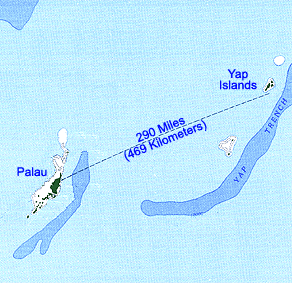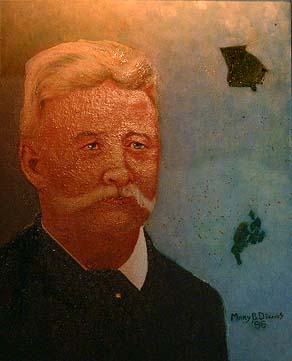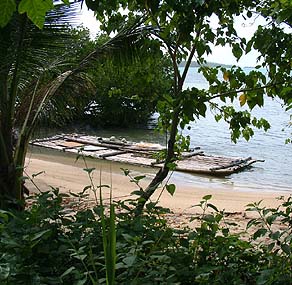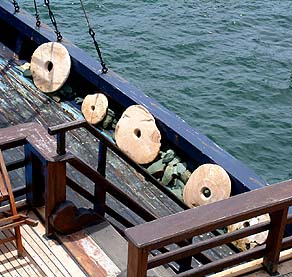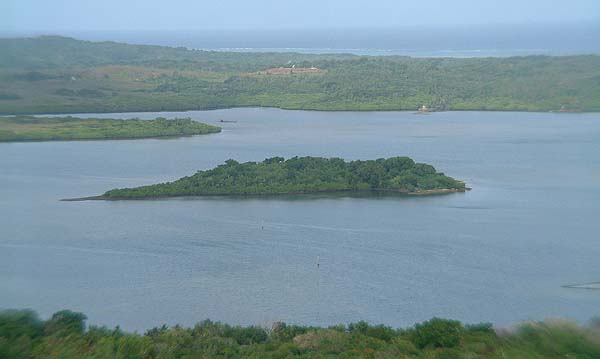| O'Keefe and Yap:
|
“O’Keefe was a fugitive from Georgia," Cal explains, "who jumped ship because of some wrong doings that he supposedly had done, and he was afraid that he was going to be jailed. So he got on a ship and then took off, hoping to go as far away as possible.
|
||
| |
||
"On his trip out here, he was shipwrecked, and he was washed up on the shore of Yap. Here he was taken in by the local folks here and kind of nourished back to health. "And when he got his health back, he found the islands to be to his liking. He saw a lot of opportunities for establishing himself. He found that there was a market for copra trading and the sea slug here, so that’s how he got started." “When he came here, there were already one or two German representatives living here on the island who were running the German-based businesses trading in the copra industry and sea slug. They were not very successful because they were having a hard time trying to get the Yapese to give them a helping hand."
|
|
|
“But O’Keefe found a way to get the to Yapese work for him and with him. At that time, the Yapese were already quarrying stone money on Palau, but they are doing it using canoes and rafts. "It could take them years, at times, to go sail there and spend time to carve the stones, then shape them, fit the sizes that they wanted, and then put them on the raft and tow them back. So it take months and months of work, and it was really a laborious process." “They were using just very basic tools, the rough tools. Sometimes the metal was not really shaped to do that kind of work, so they were just using their ingenuity to carve the things out of the stone."
|
"And all the way around it’s a fairly dangerous venture: people lost their lives on the cliffs because they had to climb up and quarry or cut out the stones, and then had to descend the cliffs, trying to bring those things down to the ground where they could work with them. "And then from there, when they get on the canoe, some of the canoes don’t make it back home—they got lost and they were never found again. So the more labor attached to your piece of stone, or the more life lost in the quarrying of a piece of stone, the more valuable it is. “As I understand it, O’Keefe would take a bunch of Yapese from here and he would go to Palau and have them quarry their stone money. He provided some tools for them also, so it made it easier for them to work. And then he put them on his Chinese junk, a big boat, and they brought them back to Yap." |
|
|
|
|
|
"Then he would keep the stones in a place and he would attach value to them. He would say, ‘So many bags of copra and you can get one of these stone money.’ And so people were working hard trying to trade in exchange for those stones.
|
||
|
|
||
"Sometimes he would make arrangements with the village people or clans for them to just go with him to Palau, get those things for them. When they came back, they agreed to give him so much tonnage of copra. “So he was playing the mentality of the islanders. He was using that as a leverage, to get the stone money for the Yapese and the Yapese to help him get this copra. And it was working for him. "But he also sort of devalued the stone money, because of the more efficient way in which they were quarried. So he made it easier for the Yapese to get them, but the value sort of went down."
|
|
|
“Through that relationship with the Yapese, he was able to use a lot of the laborers here, and that’s how his business and enterprise grew to the point where he was a very wealthy person. In those times he was traveling back and forth between here, Hong Kong and the Philippines, and extending his trade to the neighbor islands. “O’Keefe was in fierce competition with the German traders—so much so that they had several run-ins. They were each working through the local populace here to factionalize them and try to go at each other, but O’Keefe was more influential because of his dealing with the Yapese here. And they were in fierce competition for who dominated the island in term of the trade. "But I guess O’Keefe won out in the end. And the Germans had to yield the island to O’Keefe and then they move on to other ventures elsewhere in the Pacific."
|
|
|
|
|
“I understand he had several wives. One, the most prominent one, was from the island of Nauru, who he brought back and they lived on the island that is now called O’Keefe. But he kept mistresses all over the place, including the Outer Islands. "And then during one of his trips, either to Hong Kong or the Philippines, he disappeared, and people suspected that he probably got lost in a storm and never found his way out. He was shipwrecked in one of those storms, and that’s the end of him as a person. But his legacy continued on, because of his influence in the bringing of the stone money from Palau.”
|
||
|
|
||
|
|||||
|
|||||

